Chilcompton Tunnel
A gorgeous recreation of the Somerset & Dorset Railway in 'OO' gauge was STEVE JONES' aim, and this beautiful exhibition layout recaptures the days of the S&D before its premature closure. Photography, Trevor Jones.

Above: Stanier ‘8F’ 2-8-0 48706 heads towards Chilcompton Tunnel with a fitted freight as last-built BR ‘9F’ 2-10-0 92220 Evening Star powers the ‘Pines Express’ out of the tunnel headed by a Gresley Corridor Second.
TO SOME the ‘Slow & Dirty’ and to others the ‘Serene & Delightful’, the Somerset & Dorset Joint Railway (SDJR) has always attracted interest and debate amongst enthusiasts. Whether it was the scenery through which it traverses, the motive power, the romance of travelling to holiday resorts on the south coast from towns in the north or the famous ‘Pines Express’, the line attracted bands of enthusiasts who fortunately for future generations had the forethought to record the scenes on film.
Ivo Peters became my main source of inspiration during the building of Chilcompton Tunnel and the compilation of train formations. Where else could you see Midland locomotives double-heading with Southern types? There was coaching stock from all four main regions and, apart from Eastern Region locomotives, representatives from the Southern, Midland and Western regions in one place. A house move from Berkshire to Wiltshire in 2001 brought the unexpected advantage of being within striking distance of locations such as Radstock, Midford, Midsomer Norton and Bath (Green Park) a mere 20-minute drive away or a pleasant cycle ride.
Preservation groups at Midsomer Norton and Shillingstone continue to restore small sections of the line and some have, rather hopeful, ambition to re-open the entire route. The group at Midsomer Norton hopes to relay track through the tunnel in the fullness of time, once tons of household waste have been removed from the cutting on the lead up to the northern portals. The station has been beautifully restored and there is a wonderfully evocative atmosphere. I understand that the local authority is supportive and the group has access to the track bed towards Radstock – much beyond that is difficult to imagine due to development.

Above: The driver of Fowler ‘4F’ 44331 waves to the photographer as it heads north and passes a BR ‘4MT’ 4-6-0 at Chilcompton.
LOCAL INSPIRATION
The original inspiration for the layout was a photograph in The Somerset & Dorset in Colour by Mike Arlett & David Lockett. I decided that the layout would follow my tried and tested format of trains running through the landscape. I am also involved in the maintenance and exhibiting of Sydney Gardens (HM102) which proved that a simple mainline track plan has great appeal. The original concept behind that layout was that alternative scenic sections could be dropped in, utilising the existing and extensive storage yard at the rear. This would save an enormous amount of time and money in the construction phase. The whole scenic section of Chilcompton Tunnel took no more than six months to build.
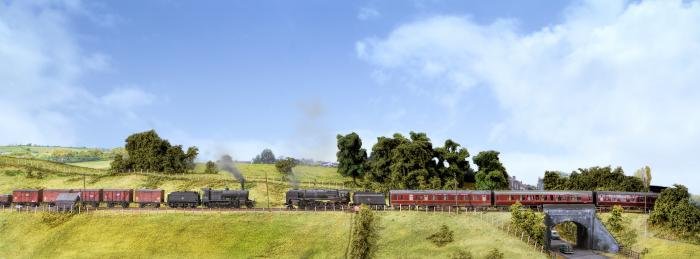
Above: A Fowler ‘7F’ 2-8-0 leads a mixed goods south from the tunnel as a ‘9F’ heads the northbound ‘Pines’.
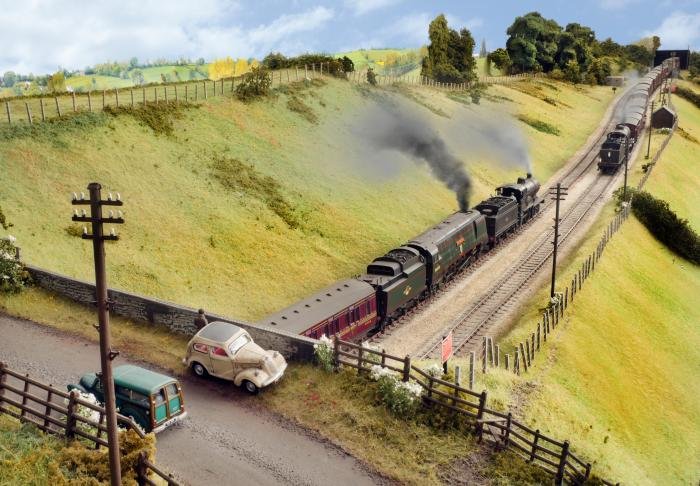
Above: Enthusiasts look on from the road over Chilcompton Tunnel as a Fowler ‘2P’ 4-4-0 and Bulleid ‘West Country’ 4-6-2 combination head south. A Fowler ‘7F’ 2-8-0 is working tender first towards Bath Green Park with a mixed goods.
The real Chilcompton Tunnel is no more than a 25-minute drive from home and is reasonably accessible to photograph, although the actual tunnel mouth and area immediately in front are fenced off - it is owned by a local gun club and used as a firing range. Access to the track bed can be gained by a public footpath adjacent to the tunnel and steep path adjacent to the bridge in Chilcompton village. Whilst the trackbed over the bridge is fenced and overgrown, and presumably in private hands, the trackbed from the bridge to the tunnel can be walked with ease, affording views across the countryside to the tunnel. In fact, the photographs for the backscene have been taken from vantage points on the trackbed. In reality the views are on the opposite side of the valley but they help to give the layout a sense of place. That said, the views above the tunnel are of Midsomer Norton accurately located in the distance and the lane is a photograph of Tunnel Lane stood in the middle of the carriageway on top of the tunnel. I spent many hours exploring and photographing the remains of the tunnel mouths, road bridge, pill boxes and trackbed, usually tied in with a visit to Midsomer Norton station. This enabled me to scratchbuild the tunnel mouth using Slaters embossed plasticard sheets. I was keen to replicate the distinctive repair patches of stone and brick so I carefully chopped sections out, with close inspection of photographs to give the impression of the original. A little filler here and there and some Wills brick arches and the key feature was completed.
CONSTRUCTION
The scenic section consists of two 5ft long baseboards and a single 2ft long board (all are 2ft wide) which slot conveniently into the existing storage yard. I was keen to have the landscape falling away in the foreground as per the prototype so an open style baseboard frame was necessary. Basic features such as the roads and contours of the landscape were formed using mount board and interwoven strips of thin card support the shell of plaster bandage. Green Scene static grasses and Woodland Scenics flocks provide the ground cover with sea moss trees. ‘Feature’ trees are from The Model Tree Shop. These can be obtained cheaply, but I always enhance them by chopping them about a bit to give a more random appearance and re-leaf them with scatter and a good dose of hairspray.
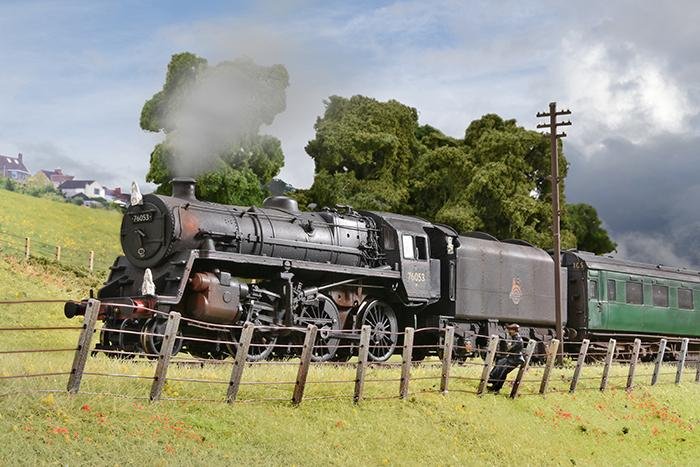
Above: The Somerset and Dorset saw rolling stock from the Western, Southern, Midland and Eastern region pass through. BR '4MT' 2-6-0 76053 heads a train of Southern Region Maunsell stock while a trackworker takes a break at the fence.

Above: A solitary Morris Minor Traveller rumbles along the road below as a Stanier '8F' 2-8-0 heads north with a van train. Scenery uses Woodland Scenics and Green Scene products together with signature trees from the Model Tree Shop.
The layout is intended to be a stage on which prototypical train formations can run. With the tunnel mouths built, attention turned to the other main scenic feature – the road bridge, known as Redan Bridge - presumably something to do with the public house – The Redan, up the road. Having seen the laser cut kits produced by LCUT at a local show, I ordered a bridge kit which I felt closely resembled the original.
I could, of course, have scratchbuilt it as I had done with the tunnel mouth, but modelling is all about compromise. I felt that by chopping some of the brickwork out and adding coarse stone to replicate repair patches, similar to the tunnel, and adding the distinctive corrugated iron sheet along the parapet it would look the part. A couple of Wills pill boxes and a plate layers hut later and the main features were sorted.
C&L flexible track has been used, and it really looks the part when carefully ballasted and weathered. I always use ‘N’ gauge ballast as that for ‘OO’ gauge just looks too big. In reality the correct size is probably somewhere in between. The finer grade of aggregate along the ballast shoulder is Chinchilla dust – available in pet shops and sold in much larger quantities than you will ever need.
Careful study of photographs will reveal that the S&D permanent way was kept in pristine condition, a feature I was keen to replicate. One detail which often draws comment is the fencing. I think there are around 300 fence posts all with five holes which needed threading with fishing line – not a job to do in one go. They are white metal castings purchased from Ten Commandments. They were beautifully crisp and I think I had to open up no more than two holes with a mini drill. They had a coat of grey primer (whilst planted in a block of wood) then a waft over with white, yellow and rust red paint either through an airbrush or an old aerosol which gave a nice spattering effect – no good for anything else but looked just like lichen.

Above: BR ‘4MT’ 4-6-0 75072 pilots a Bulleid ‘West Country’ 4-6-2 at the head of a rake of ex-LMS 57ft corridor stock.
CREATING THE TRAINS
Then it was back to the Ivo Peters volumes as my collection of SDJR locomotives and rolling stock began to grow. A couple of the guys from the Sydney Gardens gang are also SDJR enthusiasts who have their own collection of appropriate stock which is vital to fill the storage yard for exhibition running (24 trains). From photographs it was feasible to identify at least the first half of the coaching stock to give a realistic representation of the ‘Pines Express’, including on its last day with ‘9F’ 92220 Evening Star, Exmouth- Cleethorpes and Bournemouth-Nottingham services as well as less glamourous locals, fertiliser and pigeon specials, all faithfully recreated from Ivo’s photographs.
SDJR fans really have been spoiled by what is available ready-to-run – if only Bachmann would produce the early batch of ‘7Fs’ (the current model is only correct for 53806, 53808, 53809 and 53810, then there really would be very little that is missing once the Johnson ‘1P’ arrives from Bachmann.
As the SDJR has such a following the manufacturers have often seen fit to produce models of SDJR prototypes, renumbering has been largely unnecessary and is even more satisfying to know that it is one more small level of accuracy.
Double-heading is a fun feature of operation and with careful pairings we have had no operating issues. The SDJR was a steam only line apart from a few DMU excursions. In model form a diesel will pull an authentic length train without too much effort – the same cannot be said for a model steam locomotive. Double-heading on Chilcompton Tunnel is, in fact, a necessity to haul an eight-coach train around the curves from the storage yard. Operation is analogue and as well as double-heading, with care, a ‘Jinty’ can bank freights left to right - although it has to be grabbed as it goes off scene before the buffers on the wagons lock round the curve! I always enjoy seeing it scuttling back to Radstock bunker first to assist the next heavy freight flogging up the 1-in-55 gradient. Digital Command Control would assist with this but at present is cost prohibitive. Sound would be wonderful, maybe one day?
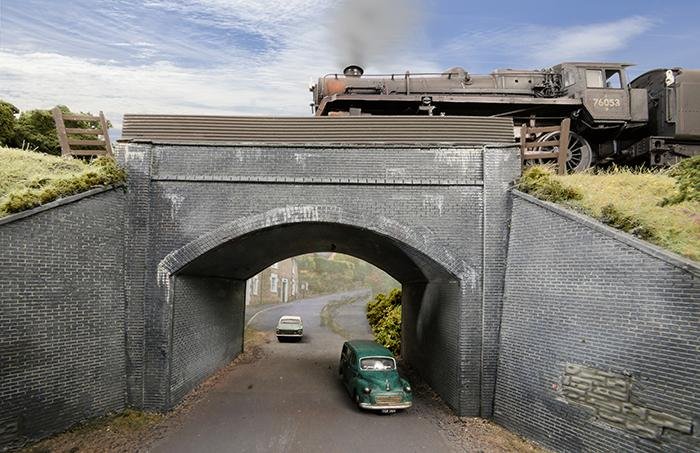
Above: BR ‘4MT’ 2-6-0 76053 crosses the road bridge as it heads north towards Bath Green Park.
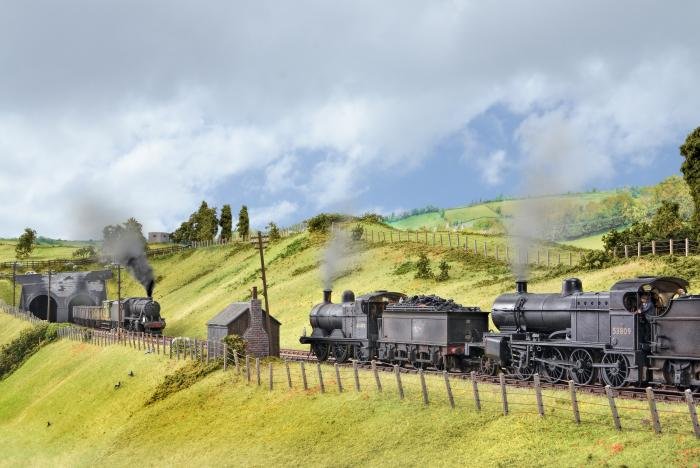
Above: A Midland ‘3F’ 0-6-0 pilots a ‘7F’ 2-8-0 heading north as an ‘8F’ 2-8-0 heads south with loaded coal from the Somerset collieries.

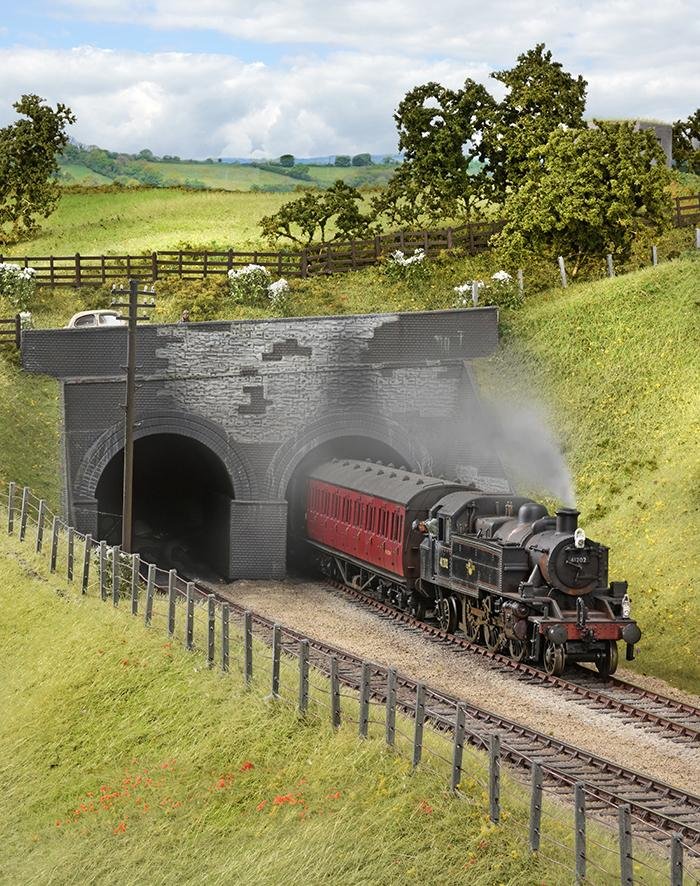
Above: An Ivatt ‘2MT’ 2-6-2T bursts out of Chilcompton tunnel with a set of ex- LMS 57ft non-corridor stock. The tunnel mouth was scratchbuilt using Slaters plasticard to replicate the real structure.
REALISM
One aspect of the hobby which I especially enjoy is weathering. To some it is a dark art but to me it is a vital aspect of operating an exhibition layout. It is critical to me that the trains sit within that landscape and both complement each other - nothing should be too shiny, too clean, too pristine. I have to point to Hornby Magazine articles for showing me the way, a relatively inexpensive airbrush and no more than three colours (enamels) - Humbrol Metalcote gunmetal (27004), Matt leather (number 62) and Railmatch roof dirt and three or four shades of weathering powder. I find that weathering has scale too and less is often more. Real coal, lamps and a crew are a must while headboards and headcodes identify the trains to miniature trainspotters.
Chilcompton Tunnel has only ventured out onto the exhibition circuit on a handful of occasions but we are looking forward to the Great Electric Train Show in 2020. My thanks go to the rest of the team (Nick, Pete, Dave, David and Peter) who help me transport the layout to and from shows, operate, and let me have access to their stock. The SDJR lives on - as those that can recount the memories first hand begin to dwindle in numbers we have wonderful cine films and photographs to relive the daily comings and goings of ‘The Pines’ slogging up to Masbury Summit with 10 coaches.

